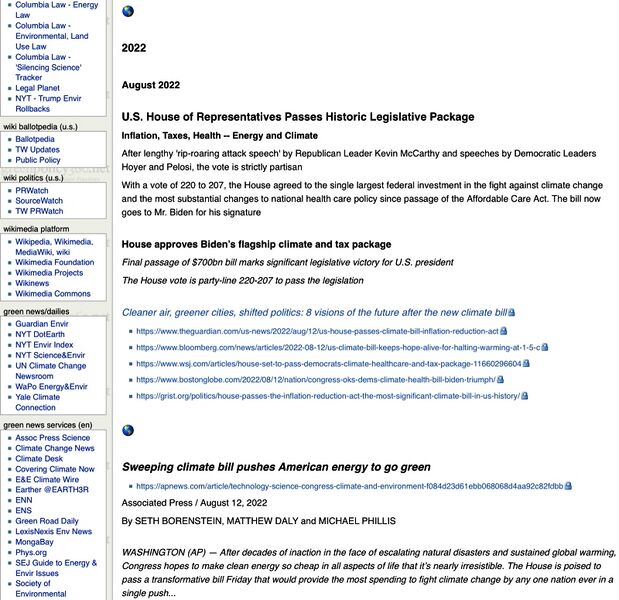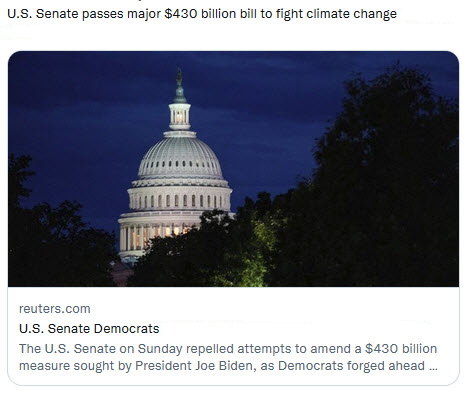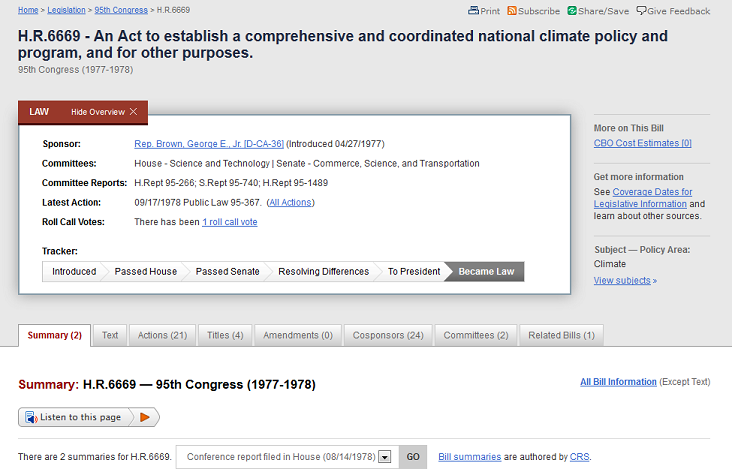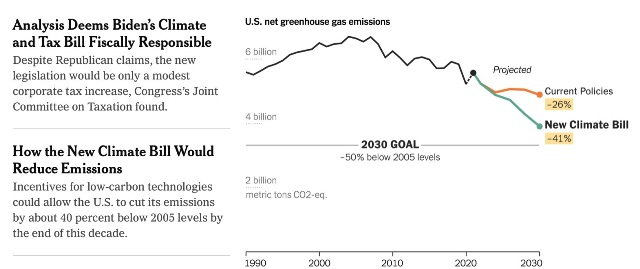File:Historic climate-clean energy vote in US Congress August 12 2022.jpeg

Original file (800 × 775 pixels, file size: 384 KB, MIME type: image/jpeg)
2022
August 12, 2022
U.S. House of Representatives Passes Historic Legislative Package
Inflation, Taxes, Health -- Energy and Climate
After lengthy 'rip-roaring attack speech' by Republican Leader Kevin McCarthy and speeches by Democratic Leaders Hoyer and Pelosi, the vote is strictly partisan
With a vote of 220 to 207, the House agreed to the single largest federal investment in the fight against climate change and the most substantial changes to national health care policy since passage of the Affordable Care Act. The bill now goes to Mr. Biden for his signature
House approves Biden’s flagship climate and tax package
Final passage of $700bn bill marks significant legislative victory for U.S. president
The House vote is party-line 220-207 to pass the legislation
Cleaner air, greener cities, shifted politics: 8 visions of the future after the new climate bill
The Inflation Reduction Act, which just passed through the House after approval by the Senate last week, is a climate investment with no parallel in US history. The spending package of $374 billion, expected to be signed into law by President Joe Biden, is aimed at turbocharging the largest economy’s belated shift to clean energy. It also has controversial sweeteners for the oil and gas industries...
Here are eight mostly hopeful visions of the (near) future from climate watchers, tech investors and activists.
Improved air quality starts at home
Healthier neighborhoods delivered by (electric) trucks
More transparent supply chains
Cities that reach 100% electrification
Slower-rising seas…
…and continued rising temperatures
An entrenched green economy
Next-generation climate politics
🌎
A Green New Deal by Another Name
- Three Legislative Actions Add Up to a New Version of a Green New Deal
- Infrastructure, CHIPS, IRA...
GreenPoliyc360: Let's look more closely at three huge advances as the US acts to deal with climate...
A Renamed and Restructured Green New Deal
🌎
More on the historic August 12th Congressional vote
- https://www.theguardian.com/us-news/2022/aug/12/us-house-passes-climate-bill-inflation-reduction-act
🌎
The U.S. action could spur other nations to do more — especially China and India, the two largest carbon emitters along with the U.S. That in turn could lower prices for renewable energy globally...
Investments work better at fostering clean energy than regulations, said Leah Stokes, an environmental policy professor at the University of California, Santa Barbara. The climate bill is likely to spur billions in private investment, she said: “That’s what’s going to be so transformative.”
Sweeping climate bill pushes American energy to go green
Associated Press / August 12, 2022
By SETH BORENSTEIN, MATTHEW DALY and MICHAEL PHILLIS
WASHINGTON (AP) — After decades of inaction in the face of escalating natural disasters and sustained global warming, Congress hopes to make clean energy so cheap in all aspects of life that it’s nearly irresistible. The House is poised to pass a transformative bill Friday that would provide the most spending to fight climate change by any one nation ever in a single push...
The crux of the long-delayed bill, singularly pushed by Democrats in a closely divided Congress, is to use incentives to spur investors to accelerate the expansion of clean energy such as wind and solar power, speeding the transition away from the oil, coal and gas that largely cause climate change.
The United States has put the most heat-trapping gases into the air, burning more inexpensive dirty fuels than any other country. But the nearly $375 billion in climate incentives in the Inflation Reduction Act are designed to make the already plummeting costs of renewable energy substantially lower at home, on the highways and in the factory. Together these could help shrink U.S. carbon emissions by about two-fifths by 2030 and should chop emissions from electricity by as much as 80%.
“This legislation is a true game-changer. It will create jobs, lower costs, increase U.S. competitiveness, reduce air pollution,” said former Vice President Al Gore, who held his first global warming hearing 40 years ago. “The momentum that will come out of this legislation, cannot be underestimated.”
The U.S. action could spur other nations to do more — especially China and India, the two largest carbon emitters along with the U.S. That in turn could lower prices for renewable energy globally, experts said.
Because of the specific legislative process in which this compromise was formed, which limits it to budget-related actions, the bill does not regulate greenhouse gas emissions, but deals mainly in spending, most of it through tax credits as well as rebates to industry, consumers and utilities.
Investments work better at fostering clean energy than regulations, said Leah Stokes, an environmental policy professor at the University of California, Santa Barbara. The climate bill is likely to spur billions in private investment, she said: “That’s what’s going to be so transformative.”
The bill promotes vital technologies such as battery storage. Clean energy manufacturing gets a big boost. It will be cheaper for consumers to make climate-friendly purchasing decisions. There are tax credits to make electric cars more affordable, help for low-income people making energy-efficiency upgrades and incentives for rooftop solar and heat pumps.
There are also incentives for nuclear power and projects that aim to capture and remove carbon from the atmosphere...
The Rhodium Group research firm estimates the bill would dramatically change the arc of future U.S. greenhouse gas emissions, cutting them by 31% to 44% in 2030, compared to what had been shaping up to be 24% to 35% by 2005 without the bill, said Rhodium partner John Larsen. Clean power on the grid, an upcoming Rhodium report says, would jump from under 40% now to between 60% and 81% by 2030, he said.
“It’s not as big as I want, but it’s also bigger than anything we’ve ever done,″ said Sen. Brian Schatz, a Hawaii Democrat who leads the Senate climate caucus. “A 40% emissions reduction is nothing the U.S. has ever come close to before.″
As decisive a change as it is for U.S. policy and emissions, it still does not reach the official U.S. goal of cutting carbon pollution roughly in half by 2030 to achieve net-zero carbon emissions across the economy by 2050.
Republicans, who unanimously opposed the bill in the Senate, say it would add to consumers’ energy costs, with House GOP Whip Steve Scalise claiming it “wastes billions of dollars in Green New Deal slush funds.”
“It’s a mark of shame that it took this long for our political system to react,” said Bill McKibben, a long-time climate activist, adding that it leaves the fossil fuel industry with too much power. “But this will help catalyze action elsewhere in the world; it’s a declaration that hydrocarbons are finally in decline and clean energy ascendant, and that the climate movement is finally at least something of a match for Big Oil.”
🌎
August 7, 2022
🌎
Steve Schmidt / Founder, GreenPolicy360: It took 45+ yrs to pass real climate action called for in the 1970s w the first National Climate Act. Our #GreenPolicy360 network thanks Rep George E. Brown, a main mover at the beginning, who'd be smiling now if he were here ...
Congressman Brown Out in Front of Climate Action
At the Beginning of U.S. Science on Global Warming, Strategies & Planning
1978, the First Climate Actions
National Climate Program Act, Public Law 95-367
In 1979 came the first follow-on National Science Academy Climate report. This study and report of national scientists was prescient and accurate in its global warming predictions.
First National Climate Act, Historic Work, 1978
GreenPolicy360 Siterunner / SJS: The beginnings of modern environmental and climate science can be traced to the 1960s and 1970s. The U.S. National Academy of Sciences played a key role in laying a foundation of scientific reports and data.
Energy and Climate Report, 1977, National Academy of Sciences / 175 pp. / PDF via GreenPolicy360
Rep. George Brown took the findings of the 1977 Energy and Climate Report from the Academy of Sciences and made the science actionable. In a historic moment, he proposed and drafted the legislation of the first U.S. National Climate Program and shepherded its passage in 1978.
🌎
Five Decades in the Making:
- Why It Took Congress So Long to Act on Climate
Bookmark Climate Policy @GreenPolicy360
Visit
○
File history
Click on a date/time to view the file as it appeared at that time.
| Date/Time | Thumbnail | Dimensions | User | Comment | |
|---|---|---|---|---|---|
| current | 15:35, 13 August 2022 |  | 800 × 775 (384 KB) | Siterunner (talk | contribs) |
You cannot overwrite this file.
File usage
The following 5 pages use this file:
- About Us
- Air Quality
- Air Pollution
- Agriculture
- Alternative Agriculture
- Antarctica
- Anthropocene
- Arctic
- Atmospheric Science
- California
- Citizen Science
- City Governments
- Clean Air
- Clean Water
- Climate Change
- Climate Migration
- Climate Policy
- Countries
- County Governments
- Democracy
- Desertification
- Digital Citizen
- Earth Imaging
- Earth Observations
- Earth360
- Earth Science
- Earth Science from Space
- Earth System Science
- Ecology Studies
- Eco-nomics
- Economic Justice
- Education
- Energy
- Environmental Full-cost Accounting
- Environmental Laws
- Environmental Protection
- Environmental Security
- Environmental Security, National Security
- ESA
- European Union
- Externalities
- Extinction
- Fisheries
- Florida
- Food
- Forests
- Fossil Fuels
- Germany
- Greenland
- Global Security
- Global Warming
- Green Graphics
- Green Best Practices
- Green Networking
- Green Politics
- Health
- INDC
- Maps
- Media
- Money in Politics
- NASA
- NOAA
- Natural Resources
- Networking
- New Definitions of National Security
- New Economy
- New Space
- Oceans
- Ocean Science
- Online Education
- Planet Citizen
- Planet Citizens
- Planet Citizens, Planet Scientists
- Pollution
- Rainforest
- Renewable Energy
- Resilience
- Russian Federation
- Sea-level Rise
- Sea-Level Rise & Mitigation
- Seventh Generation Sustainability
- Social Justice
- Soil
- Solar Energy
- Strategic Demands
- Sustainability Policies
- Threat Multiplier
- Transportation
- Ukraine
- United Nations
- US
- US Environmental Protection Agency
- Water
- Water Quality
- Water Saving
- Whole Earth
- Wind Energy
- World Bank
- World Wide Web
- Youth


